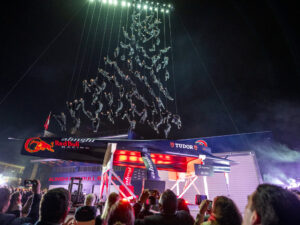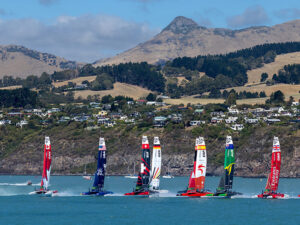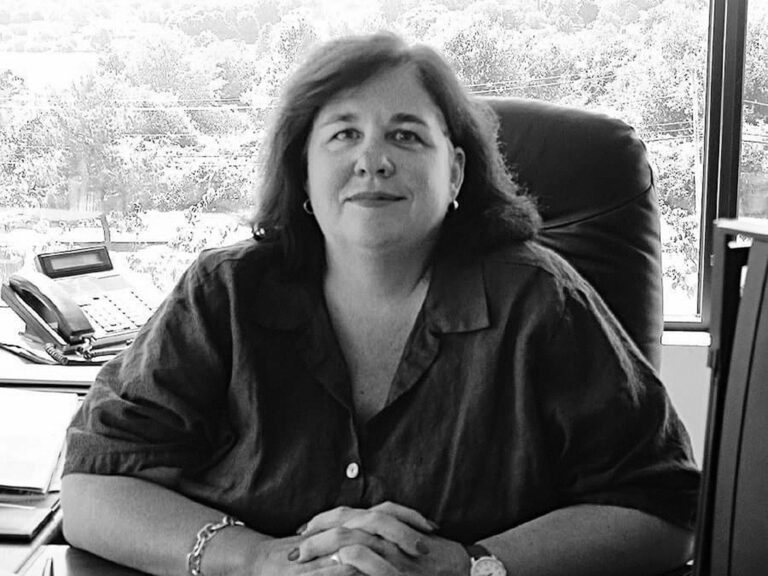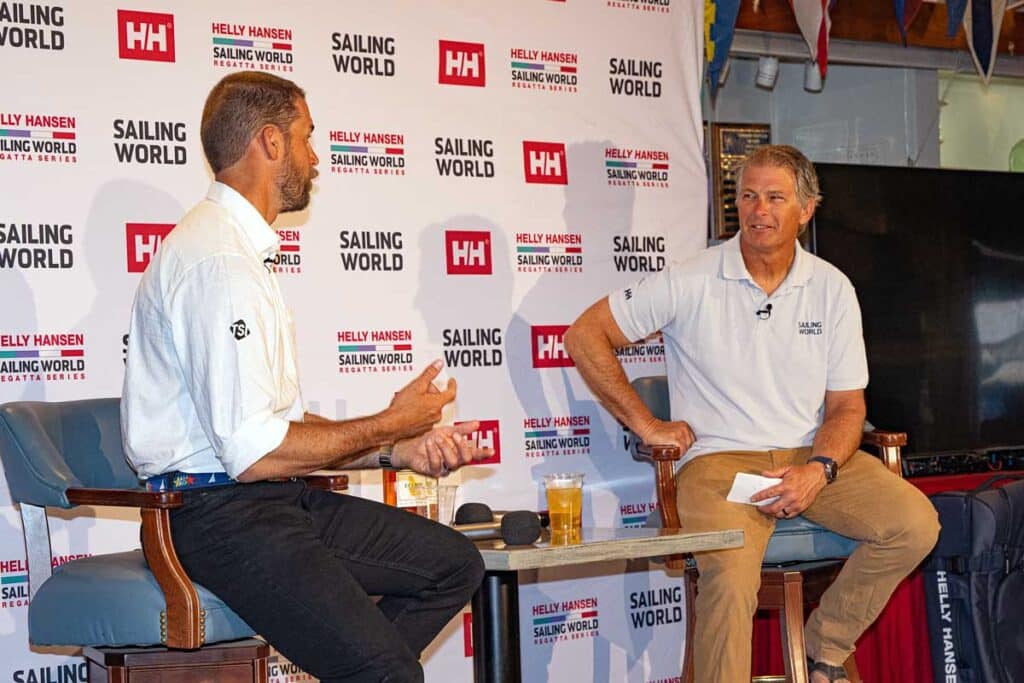
American Magic’s Flight Controller Andrew Campbell was excused from a day of training in Pensacola, Florida, to travel to his hometown of San Diego and brief Helly Hansen Sailing World Regatta Series competitors and friends on the progress of the New York YC’s America’s Cup Challenge. As the second engagement of the Sailing World Speaker Series with American Magic, Campbell shared details with Sailing World’s editor, Dave Reed, who served as the evening’s host and interrogator. Here’s what we learned.
Some challengers chose to launch prototypes, but American Magic went straight into using Patriot, the AC75 of the last Cup cycle as a development tool. Was yours the better approach?
I don’t know…that would be a question for Terry [Hutchinson]. It felt good for us to watch other teams put out little boats and know they were having little-boat problems. We go out with the big boat—heavily modified. We took the backstays off, took the bowsprit off and took off a lot of weight. We modified it straightaway, to take a different type of human power. We have cyclists onboard now—there are only four people producing power now rather than eight, so we modified it heavily to mimic how the next boat will come online next spring.
We learned a lot of lessons right away that will be hard days for the other teams to go and get. You don’t have the luxury of time late in these campaigns, so to learn those lessons early helps us plan how to set up the big boat…how we’re going to design the deck layout and the systems before we even get to design them. It’s a good thing to have in our pocket.
How much faster is Patriot today than it was in Auckland.
A significant amount. It’s hard to know if it’s just us learning to sail the boat better. For sure there have been improvements above deck. For instance, taking the backstays off is a huge aerodynamic gain and that’s what Luna Rossa was chasing last time; we had to protest to make sure they had backstays on. Those sorts of details make it significantly better around the racetrack.
It’s been said that the team’s next AC75 design will be signed off in May, so you’re pretty far along and now finally sailing the AC40 as a development boat. What more can you learn from the 40 that could find its way to the 75?
With Patriot, we know the shortcomings of that boat; we saw that boat not take off well in light air for instance. We know Barcelona will be a light-air venue so we know there will be some big changes to the hull side of the design that need to be able to bridge that gap. Sailing the 40 has been a cool iteration of hull design in a way. The 40-footer is almost a replica of TNZ’s last platform—the lines and the canoe shape bustle, so there are some interesting dynamics that it promotes in terms of takeoffs and touchdowns that Patriot was frankly very bad at. We designed Patriot as an aerodynamic platform with very little concern for what it would be like in the water and we paid the price for it. So, learning how to get out of that with a boat that still has the aerodynamic gains…Patriot is still a strong boat out of the water, but we never really got to showcase it.
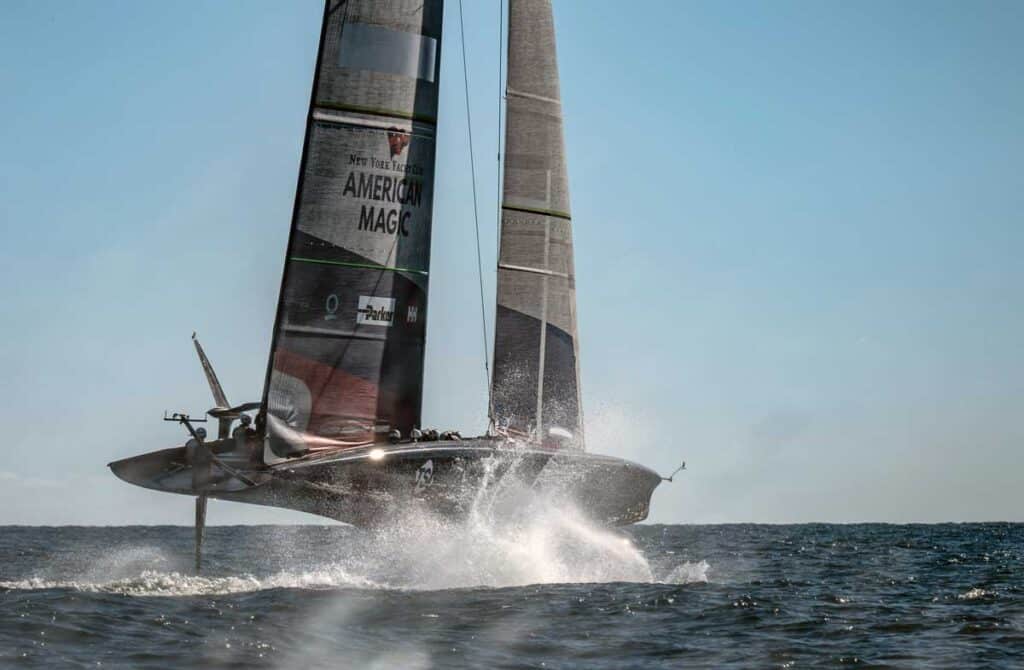
Side by side, in the simulator, against the winning Team New Zealand package, would Patriot beat it around the track today?
It’s always been competitive in terms of the amount of aero drag, but the Kiwis made a big step forward by lowering their deck…their mast ball, for example, was a few hundred millimeters higher off the deck than ours. Our mast ball was right at the deck. With their lower deck, they got to extend their sail plan down to that level and gained thrust from that. They also reduced the frontal area of their boat, which you can see when you look at the boat from bow on. But their biggest gains last time were on their takeoffs and touchdowns and stuff like that.
Explain thrust, that’s not a term sailors are familiar with.
When you think of a sail plan on any boat, if you have the foot of the jib right down to the deck and seal that gap between the sail and the deck, you’re guaranteed to have more thrust because there isn’t a transfer between the low-pressure and high-pressure sides. That’s why we’re always trying to find ways to end-plate our sails to the deck; we’re trying to endplate the boat to the water too. If you’re just skimming the hull, that maximizes the aerodynamic thrust that’s coming off the sail plan.
Is that what the skeg, or the bustle, or whatever it’s called, on the bottom of the hull is all about?
Some people call it the interceptor, but there’s a big argument in our design community because I think an inceptor is what goes across on a powerboat design, but a skeg is what you’d have across the bottom of a Sabot. Most are calling a bustle. When we first put our boat on the water it was designed with defined skeg and quite a flat bottom. If you didn’t have that piece hanging off the bottom it would be a big scow. Some teams built a hull shape there; INEOS, for example, had like a big square box. When they saw our design, all the teams extended their skeg again to get the aerodynamic gain that we’re talking about. That air hits the windward part of the hull and essentially drives a vortex underneath the skeg to prevent that transfer between the high- and low-pressure sides. It’s something that, as sailors, we are learning as new. There are some cool tricks to figuring out how to get that aerodynamic effect without giving away too much drag by putting all that extra boat in the water when you touch down. Barcelona is another can of worms, however, because the boat was designed to sail in Auckland, with super flat water, no waves to speak of, and now it will be the bumpy Mediterranean.
What’s it like transitioning between the AC75 and the AC40, which I can imagine behave very differently.
The AC40 is much more of a sports car feel. The F50 catamaran was much the same way, but this boat is even smaller and lighter. The actions that you take immediately make an impact on the platform. The AC75 is more like a bus. There’s a lot of inertia. The mistakes you make take a longer time to play out and have a bigger impact in the end. It’s not an easier platform to sail, but it is more…it just takes longer for things to play out. You can feel when it’s loaded…it just loads up and hammers around the racetrack.
The sentiment coming out of Pensacola before you put Patriot away in late February was that the team was making great strides and gains. What was working so well?
A lot of focus was putting new sailors on board. The current [AC75] rule has us sailing with eight and limits the number of power producers to four. Previously, we had eight providing power through hands. I can guarantee that all teams will have leg-powered hydraulic producers. That process has been about trialing new guys and figuring out which sailors from our last go around were ready to make the transition into cycling. Some have, which is exciting because we need those veteran athletes to be able to tell the guys not to burn out. There are some young guys that are coming in; a few had some sailing experience and a few had none at all, but it’s been fun to teach them about sailing and learn from them. They are absolute athletes and weapons and it’s great to be around them. Sailing the big boat at the level we are is a testament to how good those athletes are, and how the designers did a great job to ensure the boat was—systems wise—ready to meet that challenge. It’s a science project every day to learn how to make the boat work, to make it more efficient for the guys producing the power, because at the end of the day, we will use every ounce of power they give. Finding a way to get more from what they are giving will improve our performance.
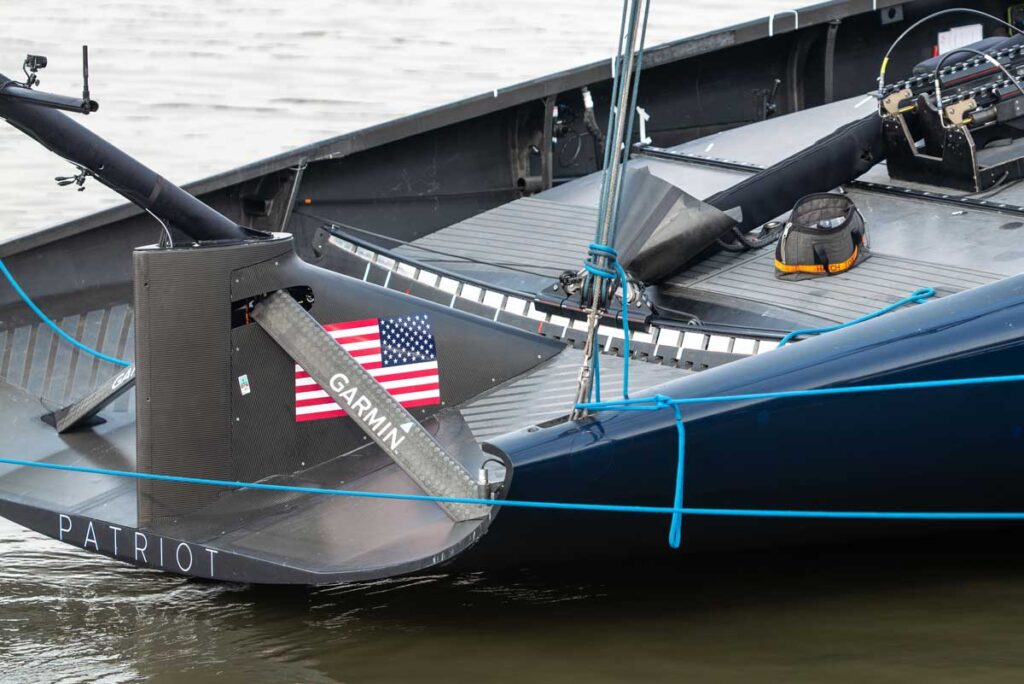
Are you, as the flight controller, demanding some of that power?
No. Flight control is all done with a power pack. It is the trimmers that have to rely on the cyclors. If they over-trim on the traveler and have to sheet back out or overtrim the cunningham and blow the relief out, those guys are spinning for no reason and there are some hairy eyeballs when mistakes like that happen. It’s a great give and take; how to produce power better and how to use power better. The cant system I control is a powered unit and the battery that I use to move the flaps has always been and will continue to be a battery.
Give us a tour of your cockpit. There is a screen and a lot of buttons as far as we can tell.
My display is a visually-oriented thing. I have a 3D-like image of the platform and it has live data about how the settings are working; how the flaps are in position; how the rudder is in position, what the trim of the yacht is, what the heel angle is, what the cant is. Come race time, it will be delayed by a second or two to ensure you can’t follow the dot and fly the boat just using the data.
As a flight controller, I can manipulate trim through the rudder control. I can manipulate the flap that moves negative to positive and I can control the cant, which is how much the foil is under the boat. Imagine we sail into a lull and we know the boat will slow down; we can either add flap and give it a little angle of attack by helping it with the rudder, or we can give it a little more cant to get lift from underneath. It’s a big puzzle that we’re trying to play in a feedback loop with the guys on the thrust side. I’m purely on the drag side of things. I only slow the boat down when I make mistakes in my world. The guys in the sail world can make my life easier by improving their thrust or make my life harder by slowing the boat down or making it unstable. When they make the boat unstable, it makes my job more difficult. When I make the boat unstable it makes everybody’s job difficult.
In Part 2 of our talk with Andrew Campbell, we’ll cover his role in the dock-out and pre-flight systems checks, what it’s like doing 50-plus knots on an AC75, the new sail-plan controls, foil developments, simulator training, artificial intelligence, and what to expect in Barcelona.



